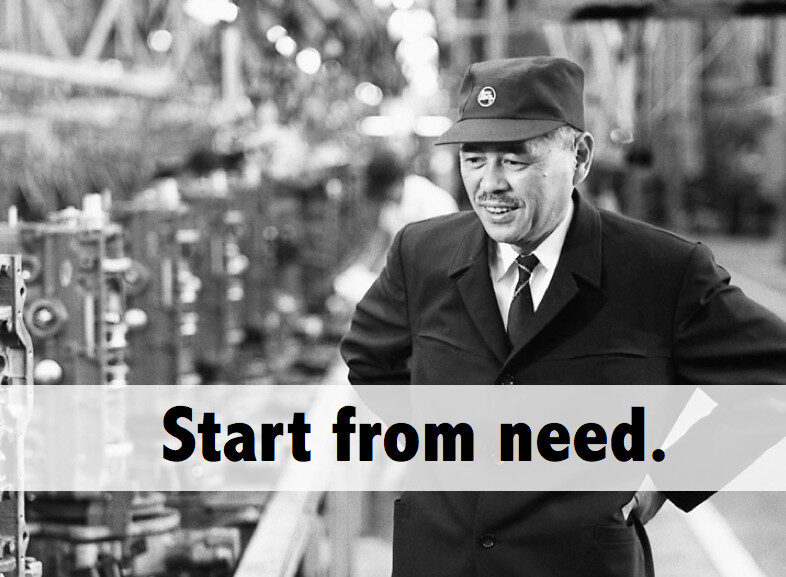As people first learn about Lean, they often ask questions like “what tools or methods should we use first?” These tools include things like 5S or varied forms of rapid improvement events. As I have heard Jim Womack say, tools are helpful, but not sufficient.
Taiichi Ohno, one of the fathers of the Toyota Production System wrote that we should “start from need.” Simple words, powerful message. What are a hospital's needs? What are the patients' needs? I think those are the right questions to ask…
One could argue nothing matters but the two pillars of the Toyota Production System, “just in time” and “quality at the source,” or jidoka. Quality and patient safety are the most important problems to work on in healthcare and these should have priority over small cost reduction exercises.
But, the pillar of “just in time” is what I'd like to talk about here. The idea of JIT in manufacturing was to provide the right part, in the right quantity, at the right time, to the right operation, customer, or process. JIT often gets confused with “low inventory,” especially in the WSJ. Actually, these two pillars are linked together, especially so in healthcare, as providing medications and materials (just in time) is a critical aspect of quality.
In the early 2000s, I learned from am experienced Japanese Lean sensei who said, “First, keep the line running…. second, low inventory.” This seemed shocking at first, as I thought the primary goal was low inventory, as did many others. But, low inventory as a primary goal often means low production (because inventory was TOO low). He taught me to keep the line running, while keeping inventory as low as possible to meet that goal (and the goal wasn't really 100% uptime, because that would require massive inventories, in most settings). We also don't keep the line running 100% of the time because the small downtimes are the way we drive improvement to prevent future downtimes.
What does JIT mean in healthcare? I can think of two examples – getting the right medication to the nurses and getting the right surgical instruments to the surgeons. We focus on meeting their needs, of course, because it benefits the patients. The first goal isn't keeping the inventory of medications or instruments as low as possible. First, provide patient care… then, keep inventory as low as possible while meeting that primary goal. But we need to be much closer to 100% availability with our medications and materials, because it could be literally life and death.
We know that nurses far too often don't have the medications they need for their patients. This often forces nurses into workaround mode – often violating formal procedures to get patients what they need. Surgical procedures are often delayed and/or staff members run and scramble to find instruments that were missing or they “flash sterilize” them or do other things that aren't optimal.
Why are we putting staff members in that position? Why are we putting patients in that position?
It's safe to assume the average Toyota assembly line worker never has to go running to look for parts. That's because Toyota factories (and other Lean factories) have support staff and systems that ensure parts are available. While there might be line stoppages or shortages of parts from suppliers in a factory, a good Lean factory generally does a better job of supporting the people who do the value adding work.
If you are working on relatively peripheral things like 5s-ing the pharmacy, but nurses and patients don't always have the medications they need, maybe it's time to step back and think about what problem you should be solving?
Please scroll down (or click) to post a comment. Connect with me on LinkedIn.
Let’s work together to build a culture of continuous improvement and psychological safety. If you're a leader looking to create lasting change—not just projects—I help organizations:
- Engage people at all levels in sustainable improvement
- Shift from fear of mistakes to learning from them
- Apply Lean thinking in practical, people-centered ways
Interested in coaching or a keynote talk? Let’s start a conversation.








![When Was the Last Time a Leader Around You Admitted They Were Wrong? [Poll]](https://www.leanblog.org/wp-content/uploads/2025/07/Lean-Blog-Post-Cover-Image-2025-07-01T212509.843-100x75.jpg)


As you stated, in healthcare, you are dealing with life & death senerios, so one MUST be serious about moving closer to 100% availability of medications & materials. However, Taiichi Ohno also said, “Where there is no Standard there can be no Kaizen.” While most Toyota line workers do not have to go looking for parts today, it was not always like that. They had to start somewhere, and that “somewhere” has to be with the basics. Every good structure needs a good foundation. Within my companies “House of Lean” we include the two pillars, but we also have the foundation which includes Standard Work, 5S + Safety, Visual Controls, & TPM, just to name a few. We also contructed a “Lean Road Map” which walks each facility through 5 phases; Planning, Starting Implimentation, Problem Solving, Full Implimentation, & finally Sustainment and Business Results Acheivement.
I say all of this coming from the Manufacturing side of things, but I am wondering what your thoughts are with regards to healthcare?
Yes, Toyota had to start somewhere. Hospitals also need to be working on the basics — getting people the tools they need to do their jobs!
The starting point for many of today’s hospitals should serve as inspiration to improve faster. Talk about a “burning platform.” Hospital CEOs and other leaders are often shielded from these problems because healthcare professionals workaround the problems and they “make things happen” and they don’t want to complain (or they don’t see the point in speaking up). We need to work toward 100% – now!
Back to your questions and your road map at your company:
1) What is your “start from need” statement. You talk about the tools you are using, but why? Same question applies back in manufacturing as it does in healthcare.
2) What does “full implementation” mean. If Lean is a way of thinking, working, improving, and managing, how are you ever fully done?
Thanks,
Mark
Mark…Sorry, I should have been a bit more specific in my explanation. Our “Lean Road Map” was created specific to our company…I work for a large organization and the road map is really a guide/plan to create consistency among the multiple facilities, it has become the “pulse” for our organization. We are now all taking the same methodical approach on our journey. Once a facility has completed the “Full Implementation” phase, it doesn’t mean they have completed their Lean Journey…as you said, we are never fully done…it is a strategic point in our journey we have determined a facility gets an internal “Certification.” Even so, PLAN DO CHECK ACT, is a never-ending circle…we will always be working on our Phase 1, 2, 3… projects, systems, etc. to sustain & improve.
OK, thanks Patrick. Not to pester you (and you don’t have to answer this of course) but what is the “start from need” statement for your organization?
Mark..I wish I could answer your question, however, I don’t know that we have a “start from need” statement for our organization. Can you give me a few examples of other “start from need” statements?
It doesn’t need to be in any particular format. I can think of one case where the staff members in a hospital microbiology lab talked through their “start from need” case (and it was in very good alignment with their leaders):
1) Improving testing response time
2) Maintain and improve quality
3) Reduce overtime for staff
[…] Lean in Hospitals: Which Tool or Which Need? […]